‘The most beautiful garden in Africa’
Our mission is to promote the sustainable use, conservation, appreciation and enjoyment of the exceptionally rich plant life of South Africa, for the benefit of all people.
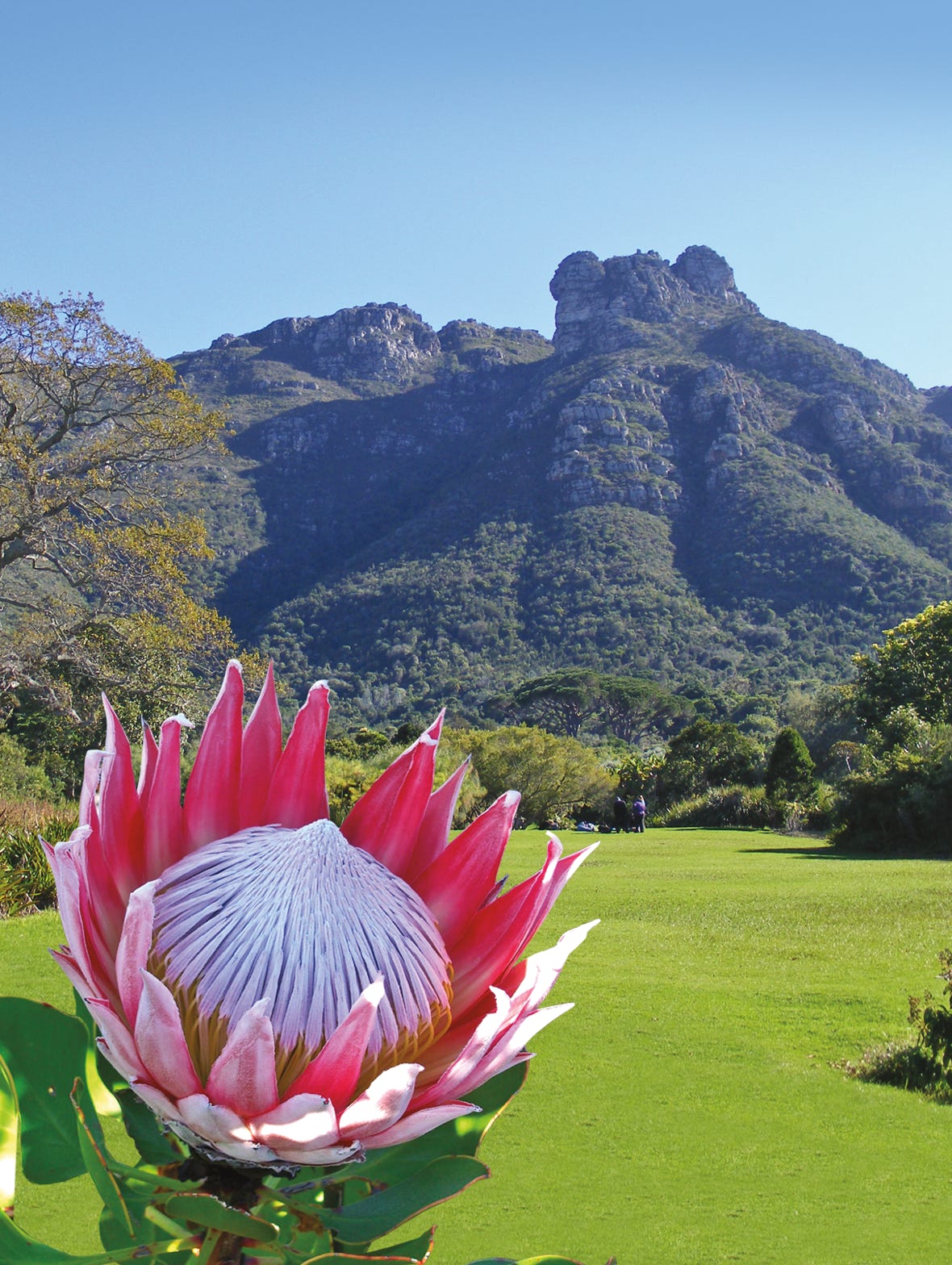


‘The foundation, only last year, of the National Botanical Garden of South Africa at Kirstenbosch, which, though the most recent of such gardens, bids fair to take a place in the front rank of the Botanical Gardens of the world, both on account of the admirable nature of the site and the remarkable character of the South African flora ...’
These were the words, on seeing the newly established Kirstenbosch Garden, of Mr A.W. Hill, the assistant director of Kew Gardens, London, in 1914 at the Silver Jubilee celebration of the Missouri Botanical Garden.
A century later, Kirstenbosch indeed ranks among the best gardens in the world, showcasing and conserving our indigenous plants, although it is also home to a number of exotic species which have been retained for historical interest.
The setting of this garden could not be more perfect, with a picture-postcard backdrop of the eastern slopes of Table Mountain in all its floral glory, flanked on the left by the affluent green suburb of Bishopscourt on Wynberg Hill, and a view to the east of the distant Cape Fold Mountains. The garden nestles in a small open valley with a number of streams meandering through, with open lawns, flower beds, bushy thickets, trees and natural areas that stretch all the way to the top of the mountain.
The garden is home to 7000 plant species under cultivation, 450 species of trees, important scientific collections, rare plants, a world-class cycad collection, as well as those unique South African arid species that cannot survive in the Cape climate – they are housed in the Botanical Society Conservatory. All this is found on 36 ha within a 528 ha estate.
Kirstenbosch is the largest of the countrywide network of nine Botanical Gardens administered by the South African National Biodiversity Institute (SANBI). Its magnificent natural setting and its situation in the remarkable Cape Floral Kingdom give Kirstenbosch a special place among its competitors in the botanical world.
The Cape Floral Kingdom is the smallest but richest in species in the world, with over 9000 species of which two thirds are endemic to the Cape Floral Kingdom – in other words, they occur nowhere else. With this in mind, it is understandable why the Cape Floral Kingdom, including Kirstenbosch, became a UNESCO World Heritage site in 2004. It has also been voted one of the seven most magnificent botanical gardens in the world.
Before there was a Garden
We know that people visited the area a long time ago, as Stone Age tools have been found near the spring in the Dell in the heart of the garden. The Khoi had made the Cape their home long before any explorers from the East or West had set eyes on the fairest Cape; the probability of these indigenous people visiting this area for medicinal plants, food and wood is high. When the first Western explorers visited the Cape and later settled for good, they encountered large groups of the Khoi who had made the Cape part of their yearly migration route. One group was the Goringhaikwa people. They arrived every October, in a large group, with their flocks and herds. Their campsite was the present-day suburb of Rondebosch and Claremont, a stone’s throw from the site of Kirstenbosch, access to which became more difficult for them on account of Jan van Riebeeck establishing his estate here.
The first recorded account referring to the area now called Kirstenbosch was written by Van Riebeeck, the first commander of the Dutch East India Company in the Cape, when he mentioned that he had surveyed the forest in 1652.
The first recorded ownership (a tentative agreement with the Company) of the site that is now Kirstenbosch was in 1657. Van Riebeeck wrote:
‘The commander today went to inspect a forest situated fully three hours’ travelling from here in the corner of the Bosheuvel, opposite the Bosbergen ... it had been discovered by free carpenter, Leendert Cornelis of Zevenhuysen, who wished to take personal possession of it ... this piece of forest was accordingly granted to him.’
The job of Cornelissen (his real name) was to protect the forest and supply the Company with timber for construction. After making a lot of money, rising above his true status and indulging in all manner of debauchery, he was expelled from the property. The future botanical garden reverted to the Company.
In 1659, the slopes of of today’s Wynberg and Kirstenbosch were put to use by Van Riebeeck on his estate, which marked the boundary of the Dutch outpost. He planted wheat, fruit trees, chestnuts and grey poplars. Because of raids on his estate by the indigenous people, Van Riebeeck planted a dense Wild Almond hedge to keep them out.
At this time, Kirstenbosch was still without its present name. A 1698 map refers to it as ‘yellow-wood forest or Lindenbosch’. Maps of the 1780s refer to it as Boshof, Claasenbosch and Bosch-Heuwel. The name Kirstenbosch appears on a 1796 British map. The general belief is that the name came from Johannes Kirsten; he operated a tollgate on behalf of the Company, near the current Rycroft Gate. He was also, at the time, the owner of the Alphen Estate in Constantia.
In 1797, Lady Anne Barnard inspected Kirstenbosch as a possible site for a country cottage, but she chose Paradys, another government forest post, instead.
Kirstenbosch became private property in 1811, the new owner being Henry Alexander, the Colonial Secretary of the Cape. He obtained only half the area of the present garden, south of the Liesbeek River. Christopher Bird, the Assistant Colonial Secretary, obtained the other half, including the spring where he built the famous Bird Bath in the Dell.
Bird sold his half to Henry Alexander 16 months later. Alexander, an eccentric, was probably the first to build a homestead in Kirstenbosch; it was reputed to have a bedroom with no windows as he maintained bedrooms were only there for sleeping. He lived there till his death in 1818.
In 1823, the southern portion was sold to W. F. Versveld and the balance to Dirk Gysbert Eksteen, a son-in-law of Henry Cloete of Groot Constantia. An account of a visit by Katharine Hilliard to the Eksteens, while spending time with Eksteen’s daughter, gives a quaint impression of the day:
‘Miss Eksteen and myself first went to the orchard and admired the ripening fruits, and then got our bonnets and books and went to La Belle Fountaine, where we spent two hours very pleasantly.’
The property changed hands once more (in 1853 to Hendrik Cloete, the brother of Eksteen’s wife) before it was sold to Cecil John Rhodes.
Rhodes wanted to keep the unspoilt flank of Table Mountain in as pristine a state as possible so, being such a wealthy man, he bought Groote Schuur Estate, including Kirstenbosch, in 1895. He planted oaks, Spanish chestnuts and camphor trees along the road which was the original road to Hout Bay. This road is now called Camphor Avenue and once used to be called Rhodes Drive. On his death in 1902, he bequeathed these properties to the nation on one condition: they must not be sold.
The Birth of a Garden
Two factors led to the establishment of the garden. The first was the formation of the Union of South Africa in 1910, which opened the way for the creation of a national botanical institution. The second was the drive and vision of Dr Henry Pearson (a Professor of Botany at the South African College, with strong ties with Kew Gardens and Cambridge University) who, six months later, started putting the wheels in motion for the establishment of a botanical garden in the Cape Peninsula which included its own herbarium, library, museum and laboratories. Pearson wanted the garden to showcase only the flora of South Africa. He also wanted the government to allocate a fixed grant to finance the garden. This was at first rejected: it took two years of hard work and championing this cause to get the final resolution passed.
In 1911, Pearson set off by cart to find a site that was state land as there was no finance to buy land. His first choice was the area that is now the University of Cape Town (part of the Rhodes bequest), but one of his companions, Neville Pillans, directed him to the present-day site of Kirstenbosch. On seeing the site, Pearson exclaimed, ‘This is the place!’ So, in 1913, Sir Lionel Philips, a man who had championed strongly, alongside Pearson, put forward the resolution to Parliament that Kirstenbosch should be the home of the National Botanical Garden. This was passed unanimously and a Board of Trustees was established. Dr H.H. W. Pearson became the first director of Kirstenbosch and J. W. Mathews the first curator.
These two men worked side by side to establish a world-class garden in less than two years. Sadly, Pearson died in 1916, and was not able to see his garden grow to maturity, but he is still a part of it as his grave is in the garden.
However, it was Mathews, who trained at Kew, who toiled to create and transform this piece of wilderness into a beautiful treasure-house of South African flora. He planned the rockeries, terraces, stone paths and lawns. He visited Namaqualand to collect seeds and rare plants. People from all over South Africa sent him specimens which found their way into the garden before he retired in 1936.
After Pearson had passed away, two years elapsed before a new director, Professor R.H. Compton, took up his position. He remained at the helm until 1953 and made the garden one of the leading botanical gardens in the world. Professor H.B. Rycroft became director after him and did a sterling job. The baton has now been passed on to the present CEO of SANBI, Shonisani Munzhedzi.
The Garden today
Werner Voigt became the new curator in 2018 after the untimely passing of Philip le Roux, who had been curator since 1999. As is necessary with any garden of this magnitude, he surrounded himself with a capable and devoted team of approximately 130 people – horticulturists, administrators, collectors, groundsmen, guides and other specialists, all there to keep a botanical garden of this size running efficiently.
What to see in the Garden
The Botanical Society Conservatory is a desert house that displays the succulent treasures of southern Africa, from tiny stone plants to the mighty baobab, the largest succulent in the world. It also features bulbs, ferns and Welwitschia. Built in 1995-96, it is the only conservatory of its size constructed to house arid-adapted flora.
The Dell, the oldest part of the Garden, features tree ferns and shade-loving plants, the focal point being Colonel Bird’s Bath.
The Cycad Amphitheatre, a natural amphitheatre above the Dell, displays this ancient plant group which dates back to the time of the dinosaurs.
The Fynbos Walk is a path that leads from the Rycroft Gate through the upper part of the Garden, planted with fynbos, a vegetation type unique to the Cape Floral Kingdom.
The Protea Garden displays members of this remarkably diverse plant family. Proteas and serrurias flower here in winter and spring, and pincushions flower in summer.
The Camphor Avenue In1898, Rhodes planted this historic avenue of trees consisting of camphor trees, Cinnamonum camphorum, and Moreton Bay figs, Ficus macrophylla.
The Mathews Rockery displays succulents and bulbs from the dry parts of South Africa. It is named after the first curator.
The Peninsula Garden presents some of the over 2500 plant species found in the Cape Peninsula.
The Arboretum displays a selection of over 450 southern African tree species in a beautiful forest setting. Created to mark the centenary of the Garden in 2013, the newly opened Tree Canopy Walkway, also known as ‘The Boomslang’, winds its way through this section.
Useful Plants are indigenous plants used in traditional medicine and for dye, mats, tea and other applications.
The Forest Braille Trail is a short, self-guided trail passing through natural forest and over a patch of wetland.
The Fragrance Garden features plants with unusual textures and scents.
The Garden of Extinction is a theme garden that displays a selection of about 1500 South African plants that may soon be extinct in the wild, with information about what has caused this and what we can do about it.
Van Riebeeck’s Hedge is a remnant of the Wild Almond hedge planted in 1660 as a boundary to the newly established settlement at the Cape.
Pearson’s Grave is on the slope above the Dell. His epitaph reads: ‘If ye seek his monument, look around.’
Colonel Bird’s Bath, which is commonly but wrongly known as Lady Anne Barnard’s Bath, was built in about 1811 to collect the spring water before it was piped into the house of Colonel Christopher Bird. The house has long since been demolished; the bath has been restored and is situated in the heart of the Dell. It was built using Batavian-type bricks and is fed by a spring that runs all year round.
The Sculpture Garden exhibits sculptures from some of Zimbabwe’s foremost artists in the Shona tradition. They were first introduced into the Garden in 1997 as a once-off exhibition, but proved so popular that it was decided that they would remain as a permanent feature.
Annuals present a show of colour in spring. Namaqualand daisies are best viewed at midday.
The Koppie showcases only tough, drought-resistant plants which survive on this well-drained sandstone outcrop.
The Erica Garden displays a selection of over 600 species.
The Restio Garden displays the Cape Reed family.
Buchus are a highly aromatic plant group belonging to the citrus family.
The Waterwise Garden teaches us how to save water in our gardens
by using the right plants.
The Fynbos Garden features a variety of plants of this vegetation type.
The Garden of Weeds presents South African plants that have become weeds in other parts of the world, with information on how to stop their spread.
The Centre for Home Gardening (Gate 2) houses a garden shop and an indigenous retail nursery, a bookshop and a gift shop.
The Vlei Garden is next to the Botanical Society Office. A boardwalk takes us over a natural seep that is rich in plant and animal life.
What to Do in the Garden
Summer Sunset Concerts are held from mid-November to early April in the open-air amphitheatre on the Concert Lawn. While you are being entertained, enjoy a picnic on the soft grass banks that slope towards the stage. The concerts cater for all musical tastes, from jazz, folk, rock and orchestral to big band swing. Many talented local artists have performed here, as well as famous stars like Elton John, Joe Cocker, Cliff Richard and Bryan Adams. The concerts have become extremely popular so book tickets in advance and arrive early to ensure a good spot.
Walks and Trails
For the more adventurous, see the illustration to get an idea of well-signposted easy walks outside the main garden. For those who want to venture to lofty heights, the two main walks to the top of the mountain are via Nursery Ravine and Skeleton Gorge. However, these routes are strenuous and should therefore only be attempted by the fit. Remember to take water, energy food, sunblock and a hat. Stick to the paths and do not pick or disturb any flora or fauna. Let someone know where you are going. Dogs are not allowed below the Contour Path.
Free Guided Tours of the Garden, approximately 90 minutes long, leave from the Information Desk, Visitors’ Centre (Gate 1) at 10 am Mondays to Saturdays. Tours are limited to 15 people and places are allocated on a first-come, first-serve basis.
Special Interest and Group Bookings can be arranged in advance via the Information Desk at a fee of R40 per person, in addition to the garden entry fee, with a minimum spend of R280 per tour.
Shuttle Car Tours of the Garden leave from the Visitors’ Centre, on the hour, daily, from 9 am to 3 pm. Book at the ticket office.
The MyGuide Self-guiding Audio Guide is available in English or German. Buy your ticket at the Ticket Office and collect your handset from the Information Desk at a fee of R40 per handset in addition to the garden entry fee.
Useful Information
While there is always much of interest to enjoy, the best times to visit are towards the end of winter, in spring or in early summer (August – November).
Entry Times
The Garden is open 365 days a year, from 8 am to 6 pm daily during winter (April to August) and 8 am to 7 pm daily during summer (September to March). The Conservatory is open from 9 am to 5 pm daily.
Disabled Access
Some visitor facilities are wheelchair-friendly. Kirstenbosch Garden is set on a very steep gradient and not all areas of the garden are accessible to wheelchairs. Disabled parking bays and stop-and-drop zones are provided at Gates 1 and 2.
Garden Rules
This garden is a living museum of plants of South Africa. To help maintain the garden and plant collections, please keep to the Yes and No rules.
Yes: Discover plants and animals • Walk, hike, explore
• Bird watch • Picnic on the lawns • Relax at concerts
• Enjoy sculptures and art • Take photographs
• Take litter home
No: Disturbing plants or animals • Balls, bikes, skateboards
• Dogs, pets • Radios, noise, games • Climbing trees, swimming
• Entering the flower beds • Litter, fires, braais
Facilities
The Information Desk (Tel: 021 799 8783) is situated in the Visitors’ Centre at Gate 1.
Ticket Offices are located at Gates 1, 2 and 3.
Main Ticket Office
(Tel: 021 799 8782) is at Gate 1.
Visitors’ Centre at Gate 1
Information Desk, gift shop, book shop, coffee shop, the Old Mutual
Conference Centre, an ATM and public telephones.
Centre for Home Gardening at Gate 2
Tea room, indigenous retail plant nursery and garden shop, bookshop,
gift shop, garden design studio,
exhibition hall and marquee lawn.
Restaurants
Moyo Restaurant
(Tel: 021 762 9585) Buffet with seafood, African, South African and vegetarian food, wine bar and the unmistakable Moyo experience of an exciting blend of design, food and entertainment. Situated near the Visitors’ Centre (Gate 1). Open from 9 am to 9 pm, Monday to Sunday.
The Kirstenbosch Tea Room
(Tel: 021 797 4883) Breakfast, lunch, tea and picnic baskets. Situated in the Centre for Home Gardening (Gate 2). Open 9 am to 5 pm.
Vida e Caffè
(021 762 6047) Espresso and high quality coffee, pastries, croissants, muffins, rolls, panini, wraps and treats. Open daily from 7 am to 7 pm (Gate 1).
Shopping
The Kirstenbosch Garden Centre is a retail nursery that stocks a wide variety of indigenous plants, seeds, garden accessories, tools, compost, etc. with experienced staff on hand to offer help and advice. Located at the Centre for Home Gardening (Gate 2), trading 9 am to 5 pm.
The Kirstenbosch Shop sells gifts, curios, clothing, homeware, botanical cosmetics and Kirstenbosch memorabilia. Located at the Visitors’ Centre (Gate 1) trading 9 am to 6 pm with a smaller satellite store at the Centre for Home Gardening (Gate 2) trading 9 am to 5 pm.
The Botanical Society
Bookshop sells a wide range of books on gardening, flora, fauna and natural history, children’s educational books, stationery and gift cards. At the Visitors’ Centre (Gate 1) trading 9 am to 6 pm with a smaller satellite store at the Centre for Home Gardening (Gate 2) trading 9 am to 4.30 pm.
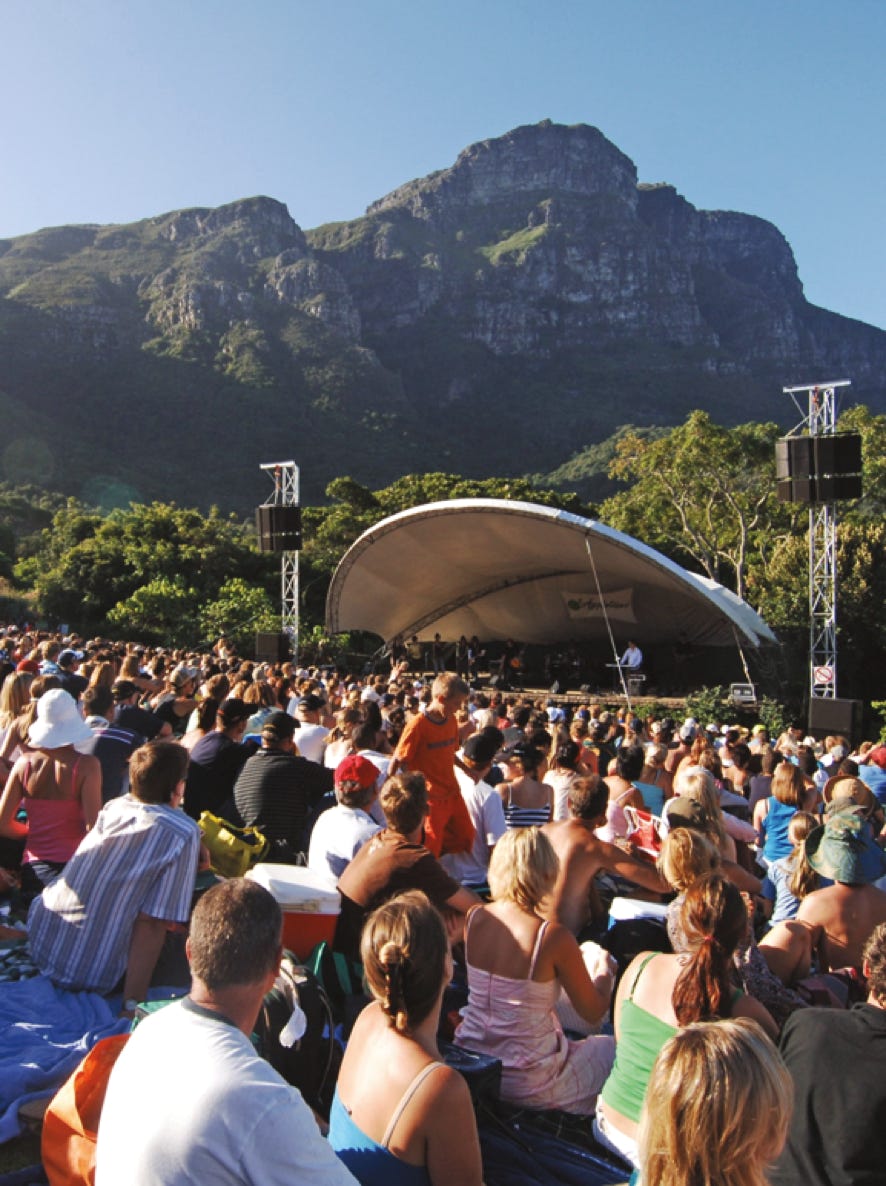
Summer Sunset Concert
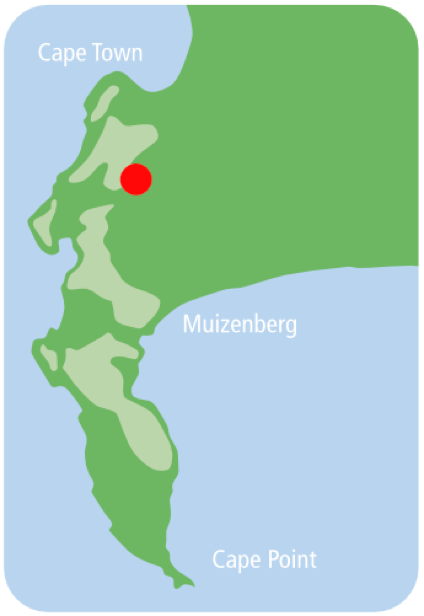
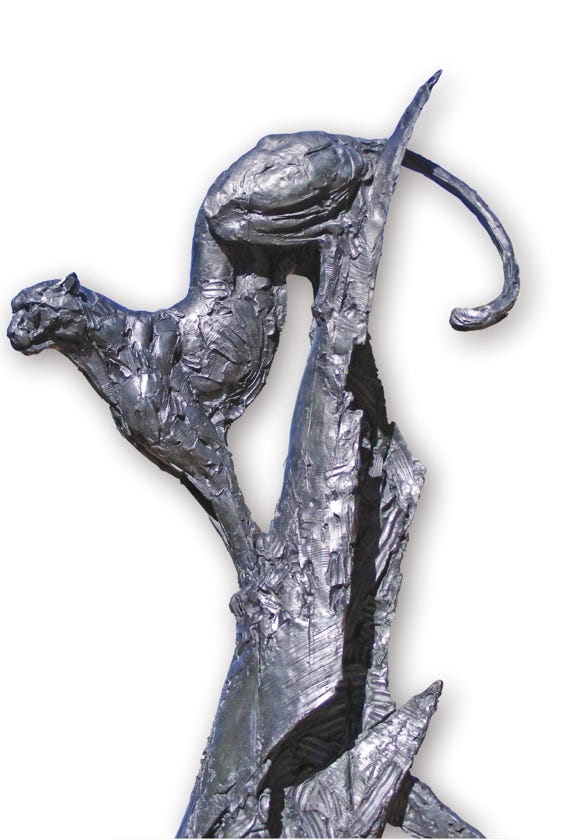
A bronze sculpture by world-
renowned Dylan Lewis, is on
permanent display, although
the sculpture is changed from
time to time.
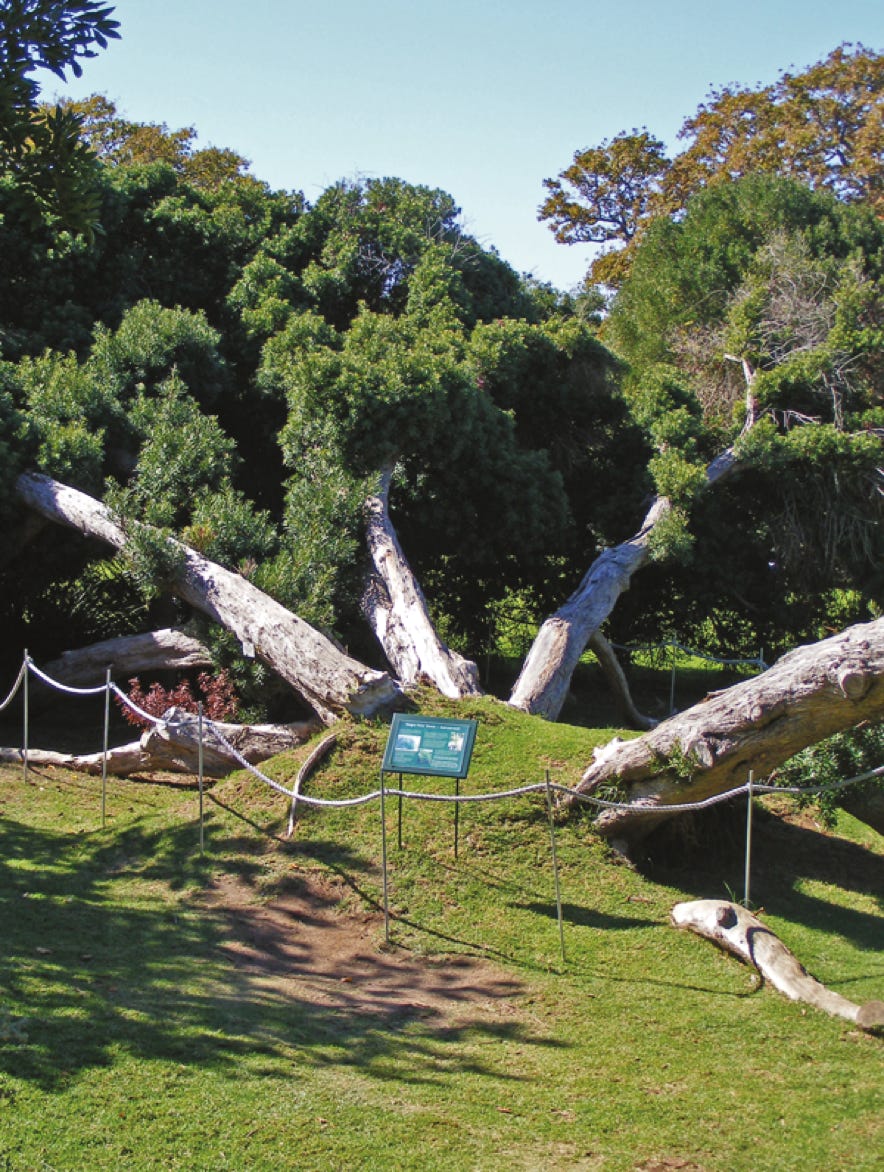
The Magic Tree
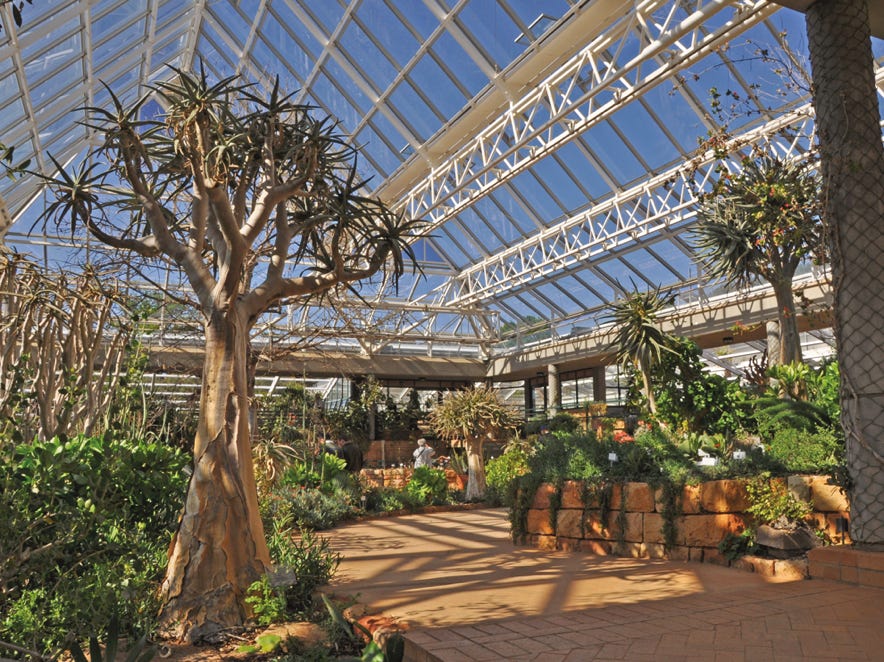
The Botanical Society Conservatory, showcasing arid-adapted flora.
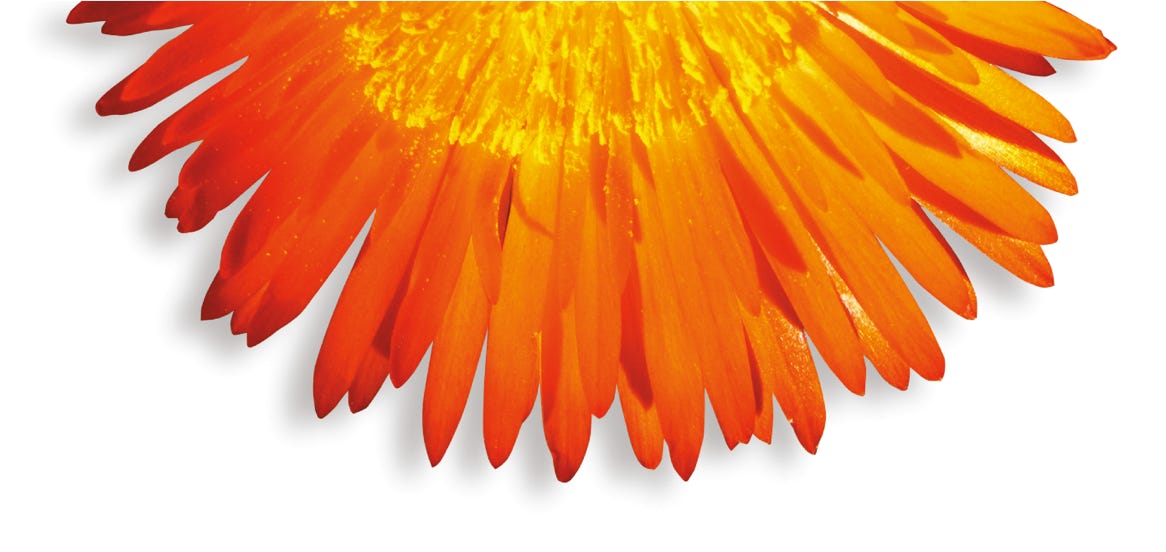
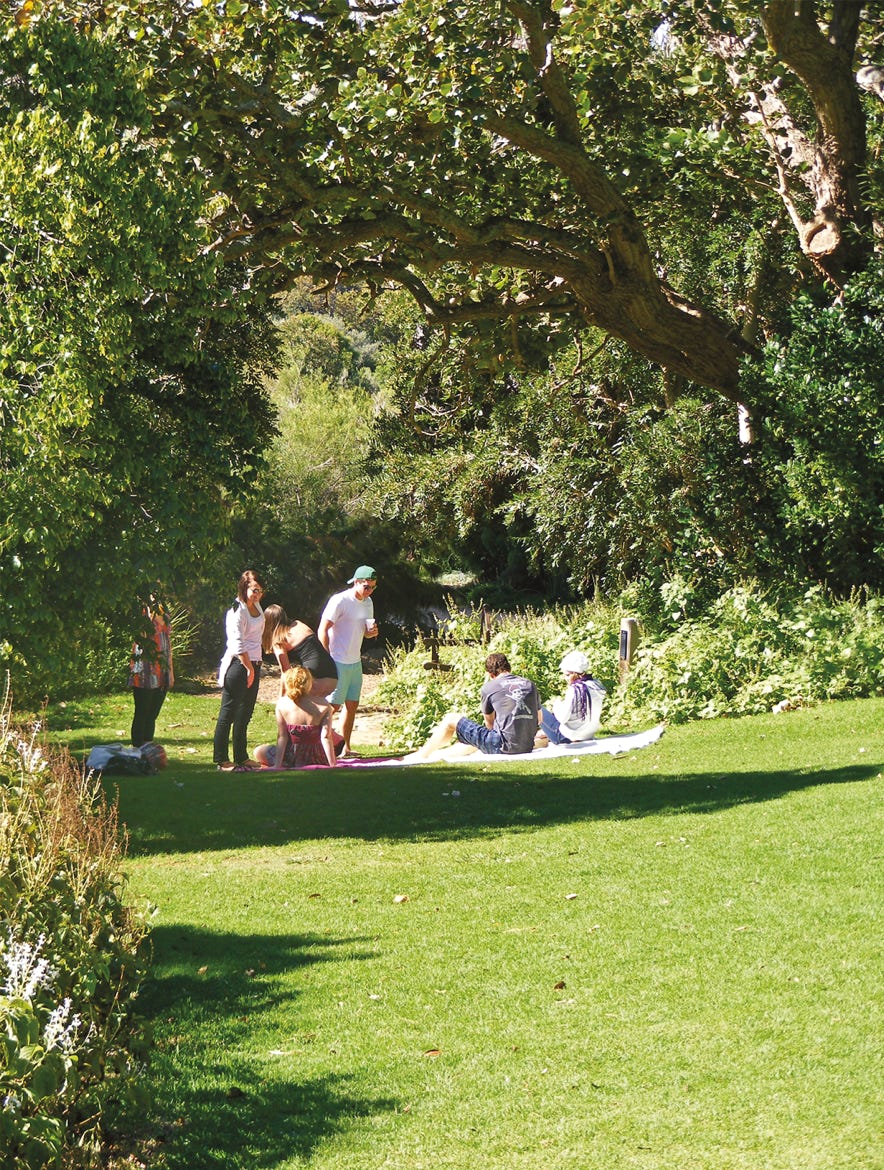
Relax with friends or family and enjoy a great picnic.
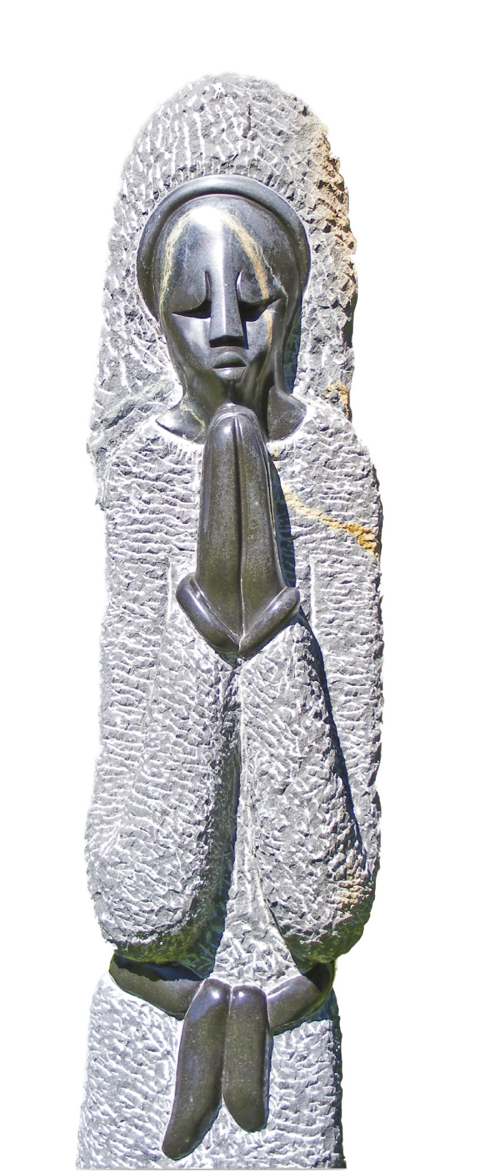
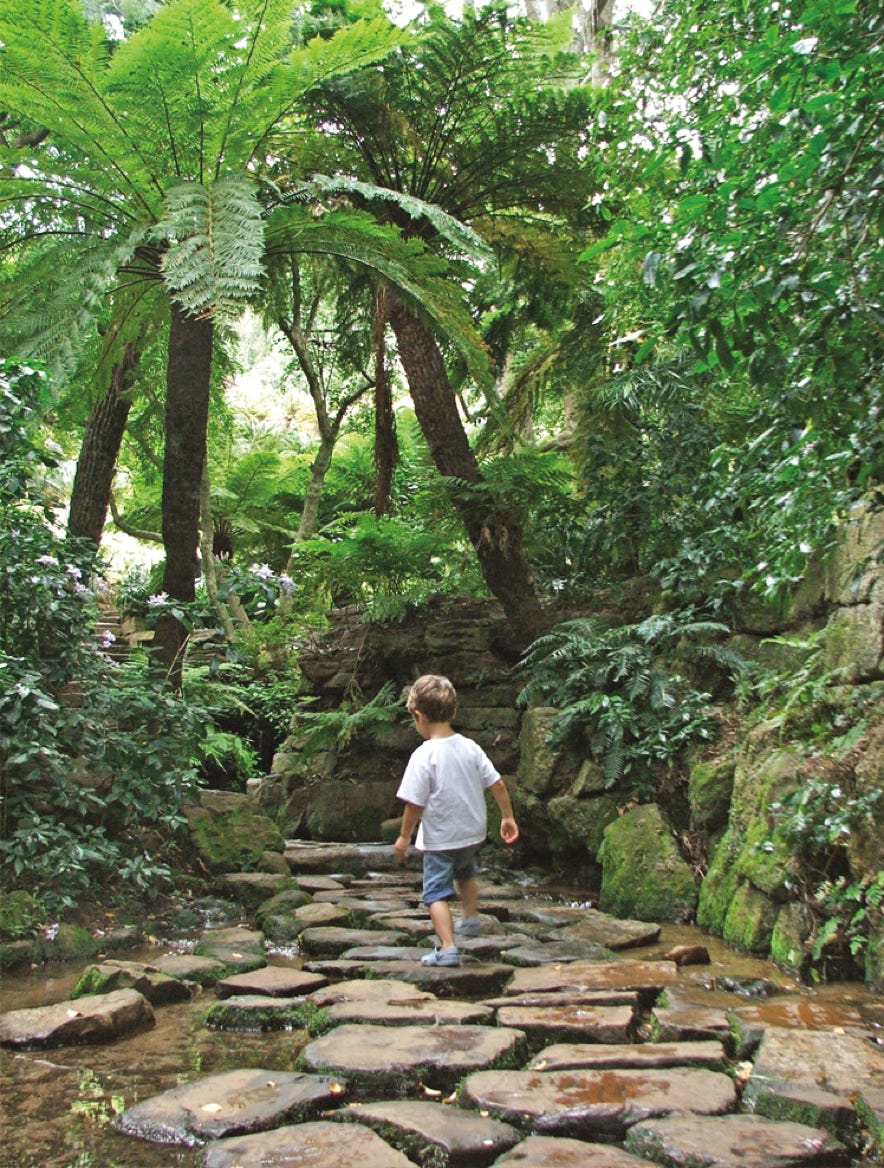
Stepping stones in the Dell

A panoramic view of the Garden showing the Main Pond (centre left) and the Cape Fold Mountains in the distance.
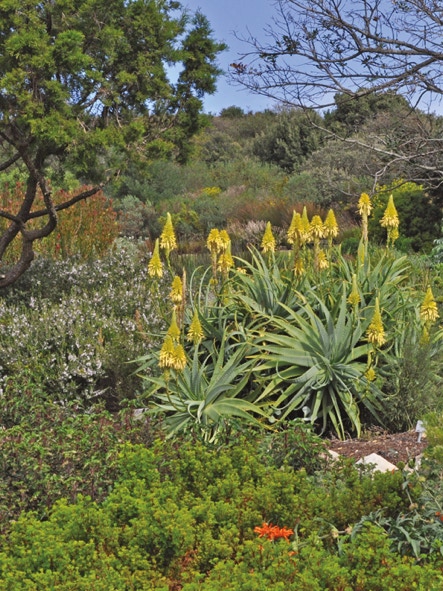
Scene from the Fynbos Garden
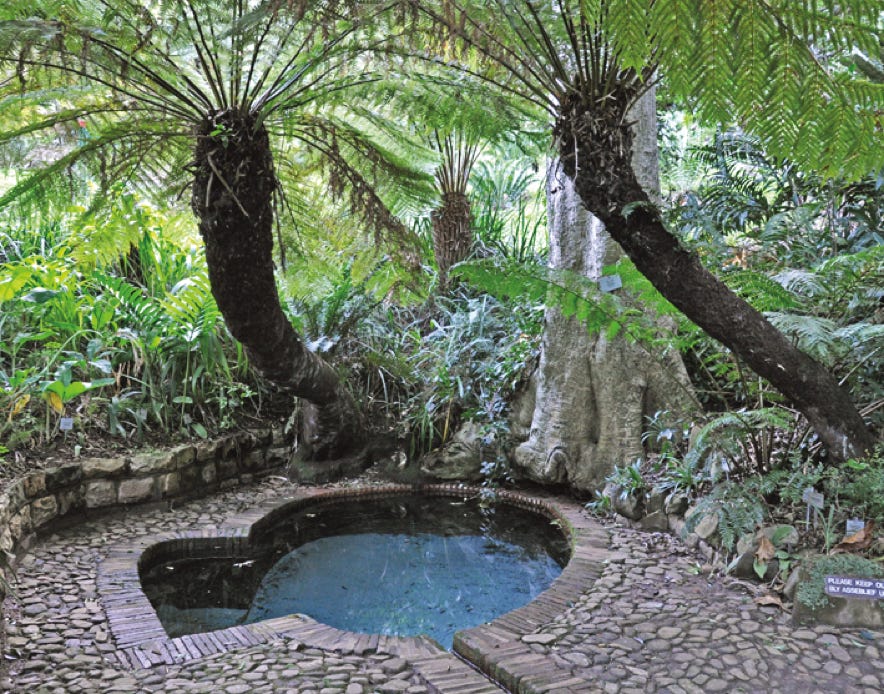
Colonel Bird’s bath is found in the Dell, the oldest part of the Garden.
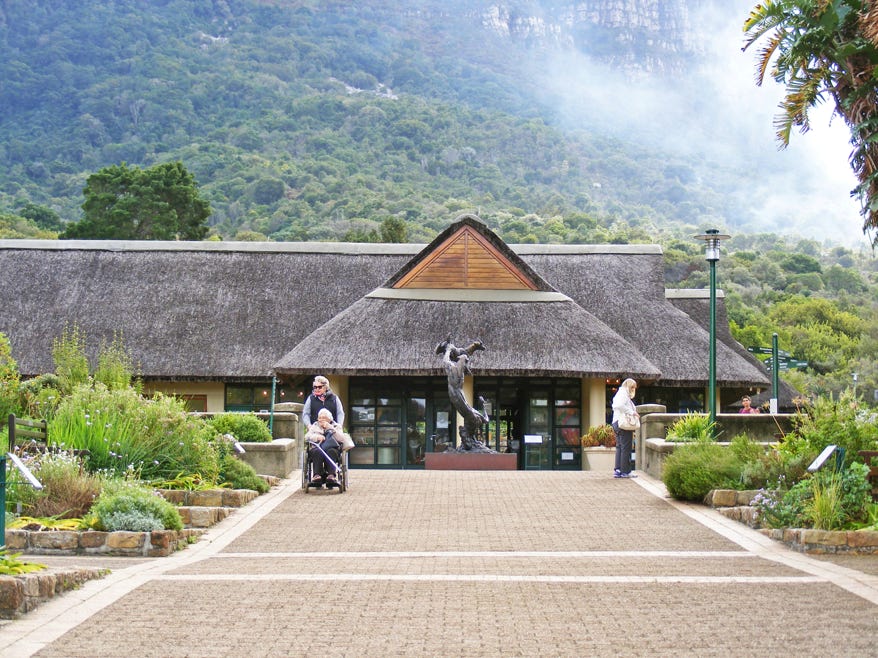
From Gate 2, there is an impressive approach to the Garden, into which one is led through paved open spaces and stone steps forming an amphitheatre.
Some of the Flora & Fauna found in the Garden
King Protea Protea family
This is South Africa’s national flower. It is the largest Protea in the Protea family and is also known as the ‘king’ of the Cape Floral Kingdom.
King Proteas grow wild in the mountains of the Western and Eastern Cape.
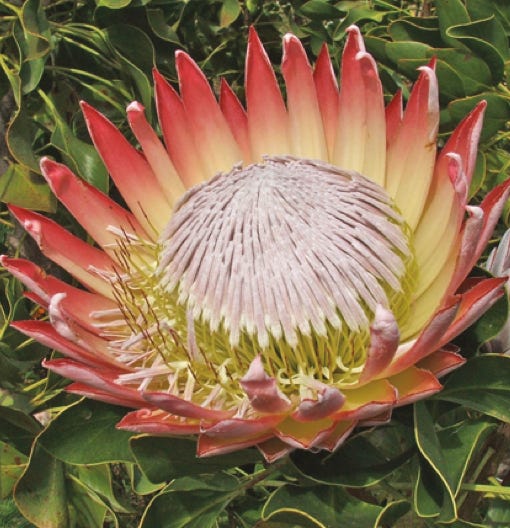
Silver Tree Protea family
These trees, with their silky silver leaves, are
unique to the Cape Peninsula. The wild
population is half what it was 60 years ago.
They are rare and endangered. You can see them in the Peninsula Garden, the Fynbos Walk and Silvertree Trail.
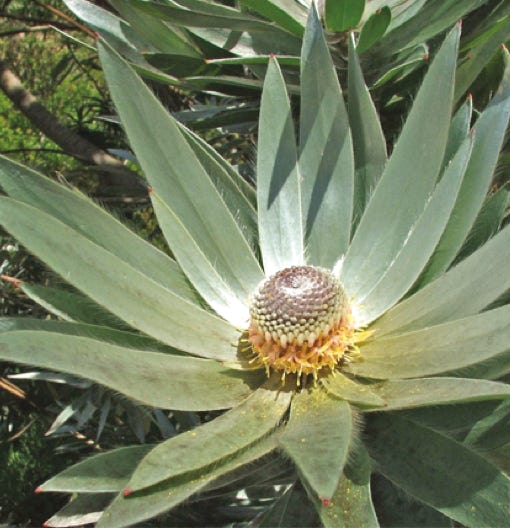
Alice Notten, SANBI
Alice Notten, SANBI
Pincushion Protea family
There are 52 species of pincushion, most of which are found in the Western Cape. They make a rewarding garden plant. They can be
seen along the Fynbos Walk and in the Protea, Restio, Erica and Waterwise Gardens.
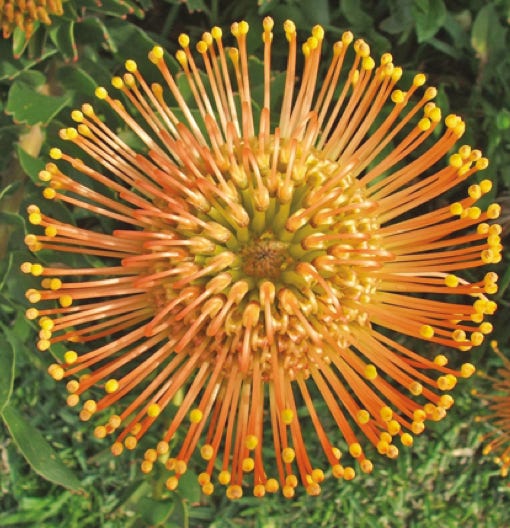
Alice Notten, SANBI
Whorled Heath Heath family
This species of Erica used to grow wild in the area between Rondebosch and Rondevlei but the spread of Cape Town’s suburbs caused it to die out by the early 1900s. It was saved from extinction and now can be seen in the Garden of Extinction and Erica Garden flowering between November and February.
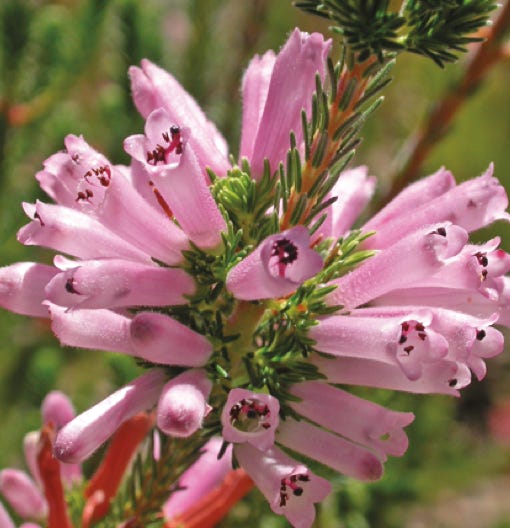
Alice Notten, SANBI
Albertina Thatching Reed
Restio family
The stems of this species are used for thatching roofs in the Cape tradition. Restios, reed-like perennials, show a great diversity of form. Some are as small and light as grasses and others resemble bamboo. See them in the Restio Garden, Fynbos Walk and the Useful Plants Garden.
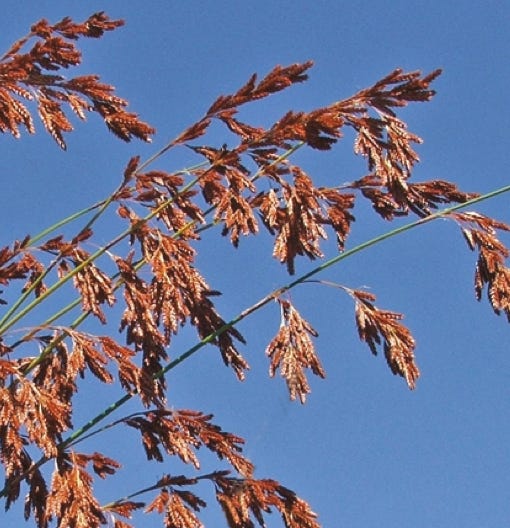
Alice Notten, SANBI
Wild Almond Protea family
It grows wild at Kirstenbosch and is famous for being the species used by Jan van Riebeeck for his hedge in 1660. See these trees at Van Riebeeck’s Hedge, at the top of the Concert Lawn and edge of the Arboretum.
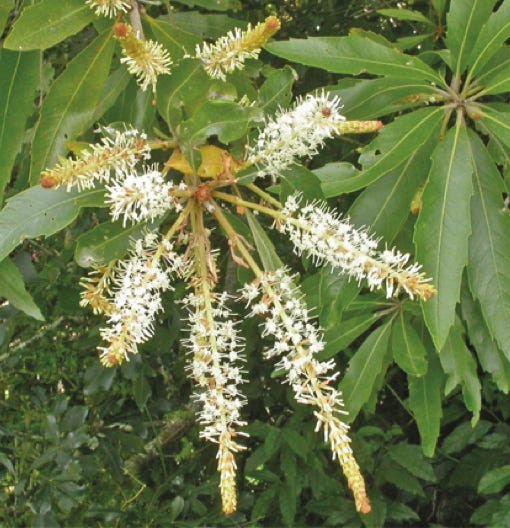
Alice Notten, SANBI
Red Disa Pride of Table Mountain Orchid family
This is the emblem of the Western Cape and is endemic to this region. Disas can be seen in flower in the Conservatory Bulb House from February to March. In the wild, they are found near streams and on mossy cliffs.
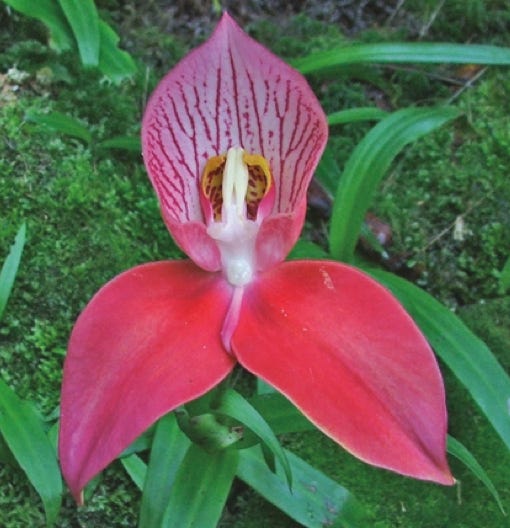
Alice Notten, SANBI
Krantz Aloe Asphodel family
This From May through July, the Krantz Aloe bears flowers of bright orange or yellow. Aloes and many other succulent plants can be seen in the Conservatory, Vygie garden, Mathews Rockery and the Koppie.
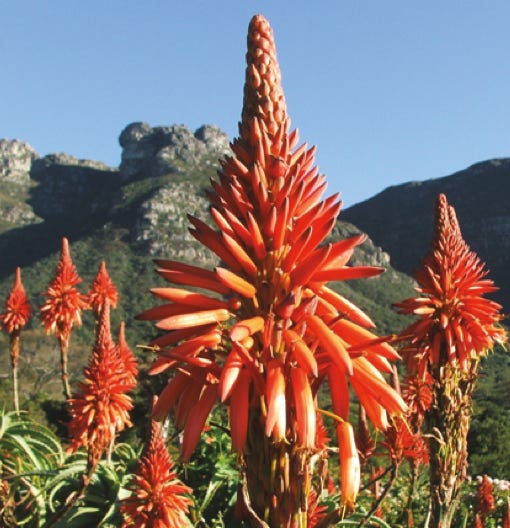
Alice Notten, SANBI
White Namaqualand Daisy Daisy family
Spring is when the Namaqualand daisies put on their annual show of colour. In addition to white, these daisies come in shades of peach, yellow, blue, orange, mauve and purple. See them in the Annual Beds, Peninsula Garden and on the Koppie.
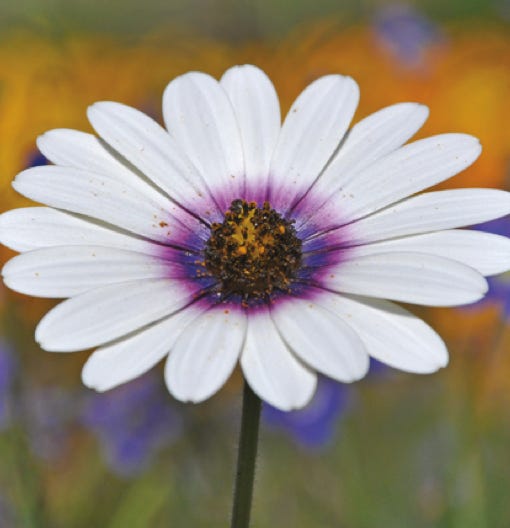
Alice Notten, SANBI
Wood’s Cycad Cycad family
This species is extinct in the wild; only 500
survive in botanical gardens and nurseries
around the world. It can be found in the Cycad Garden just above The Dell. Its base is protected from Cycad thieves by a metal cage.
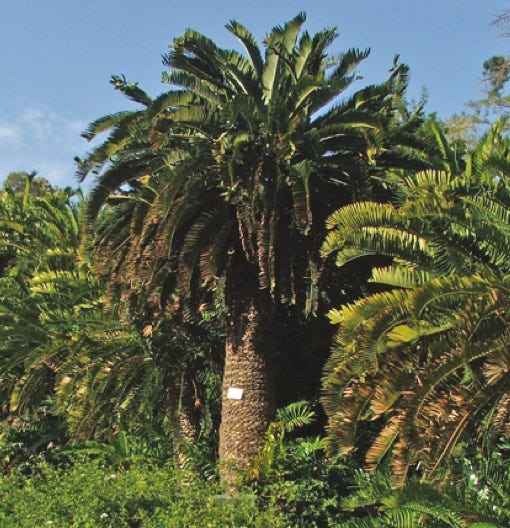
Alice Notten, SANBI
Lesser Double-collared Sunbird
These small, brightly coloured birds are natural to Kirstenbosch and visit proteas, pincushions, aloes, tube-flowered heaths and similar plants to
feed on nectar. The Orange-breasted Sunbird, with its purple collar, and the green Malachite Sunbird, can also be seen in the garden.
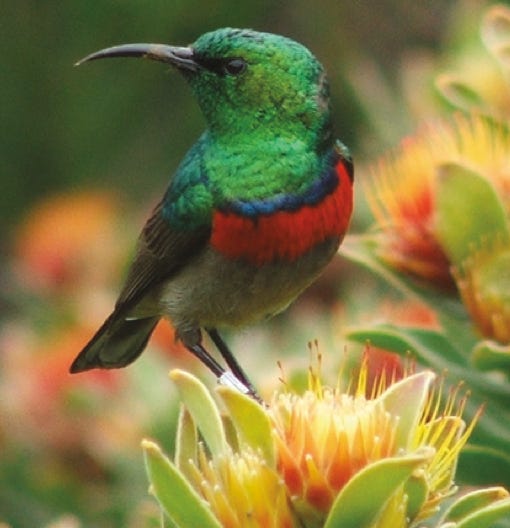
Alice Notten, SANBI
The Helmeted Guineafowl
These are common in Africa south of the Sahara, but strangely did not appear in the Western Cape prior to 1900. They can invade picnics and become quite aggressive during breeding season. Stay clear and do not feed them.
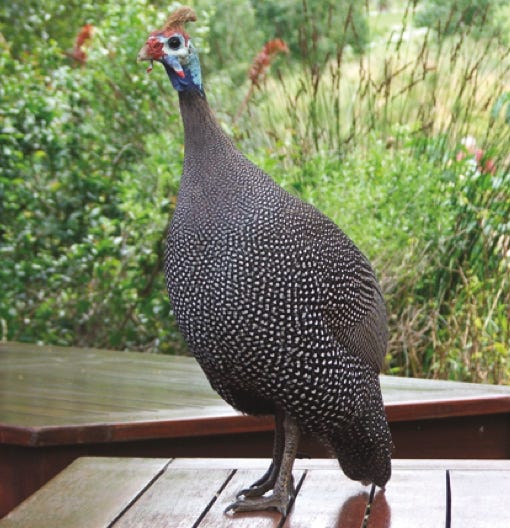
Alice Notten, SANBI
Caracal (rooikat • African Lynx)
This is a medium-sized wild cat native to Africa, the Middle East, Central Asia, Pakistan and northwestern India. It weighs about 8–19 kg and can reach a height of 40–50 cm at the shoulder.
At one time, it was rare to see one on Table Mountain but, with the introduction of the Urban Caracal Project, a lot more have been sighted.
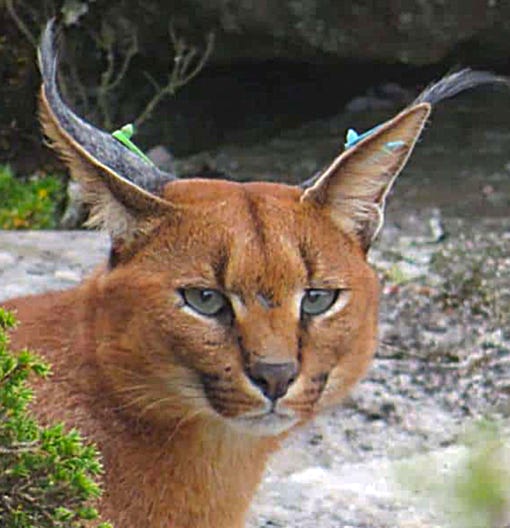
Alice Notten, SANBI
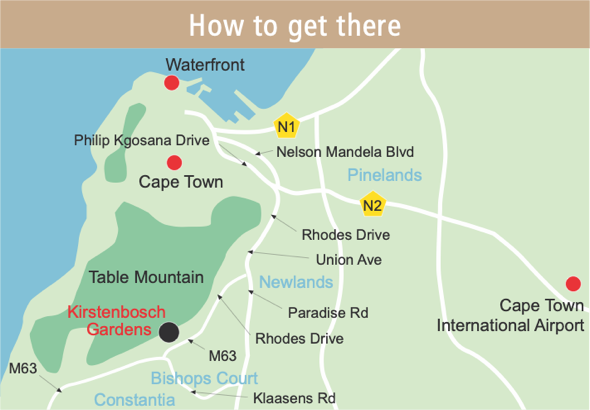
For more information
www.sanbi.org (click on Kirstenbosch)
Join the Kirstenbosch family
Become a member of the Botanical Society of SouthAfrica
Tel: 021 797 2090 • info@botanicalsociety.org.za
Editing: Shelley Brown and Shelley Woode-Smith
Thanks to Alice Notten for photographs and information
© Richard Smith • 9th edition, 2023 • Gateway Guides
Richard Smith
083 260 2985
richard@gatewayguides.co.za
richardsmith.redzone@gmail.com
www.gatewayguides.co.za
www.historicaltimelines.co.za
© Richard Smith • Gateway Guides • 2023
Distribution: GoSeeDo • Printing: FA Print
IN ASSOCIATION WITH
© Richard Smith
Citations available on request.